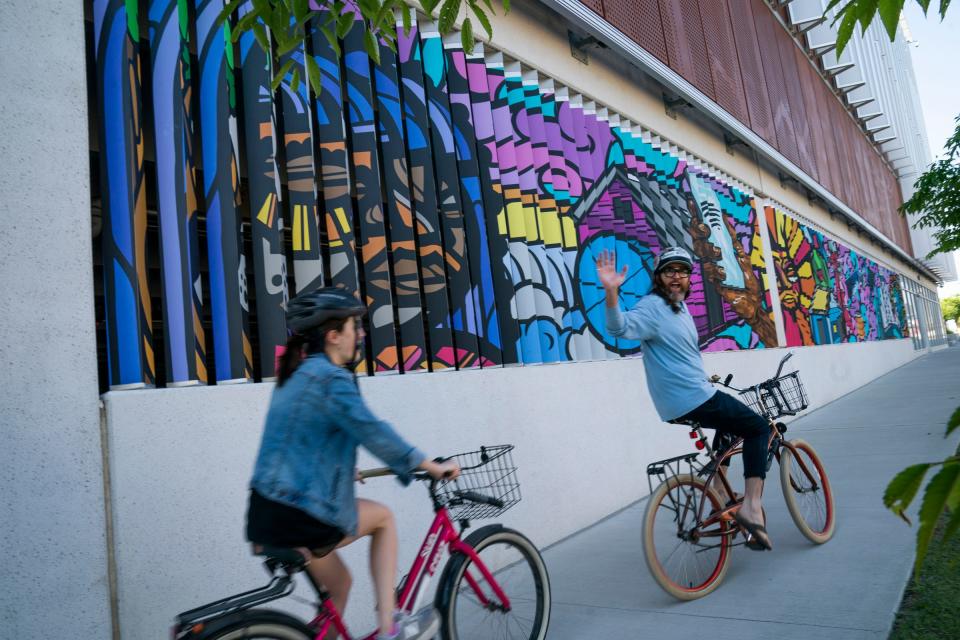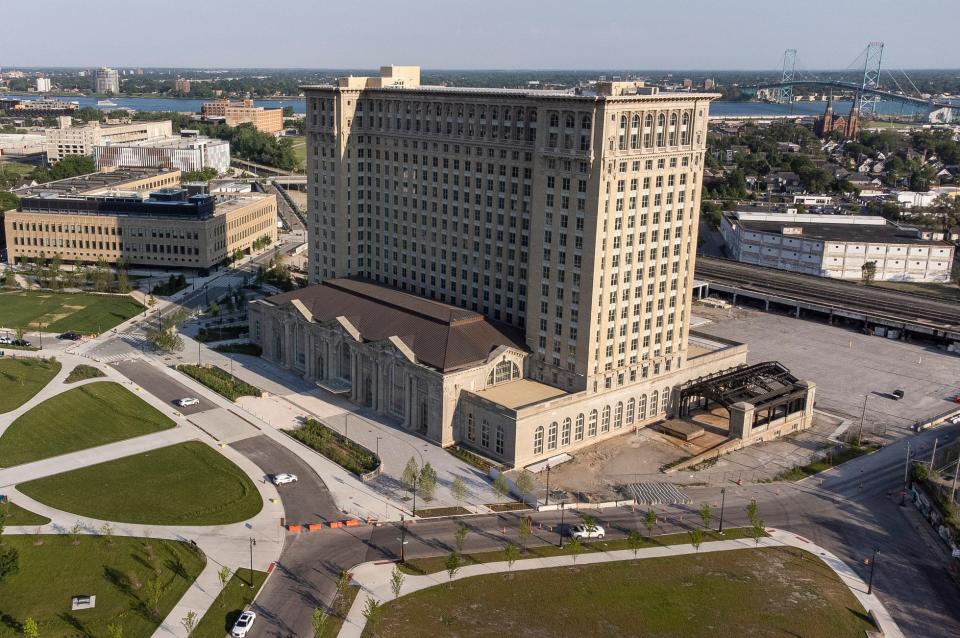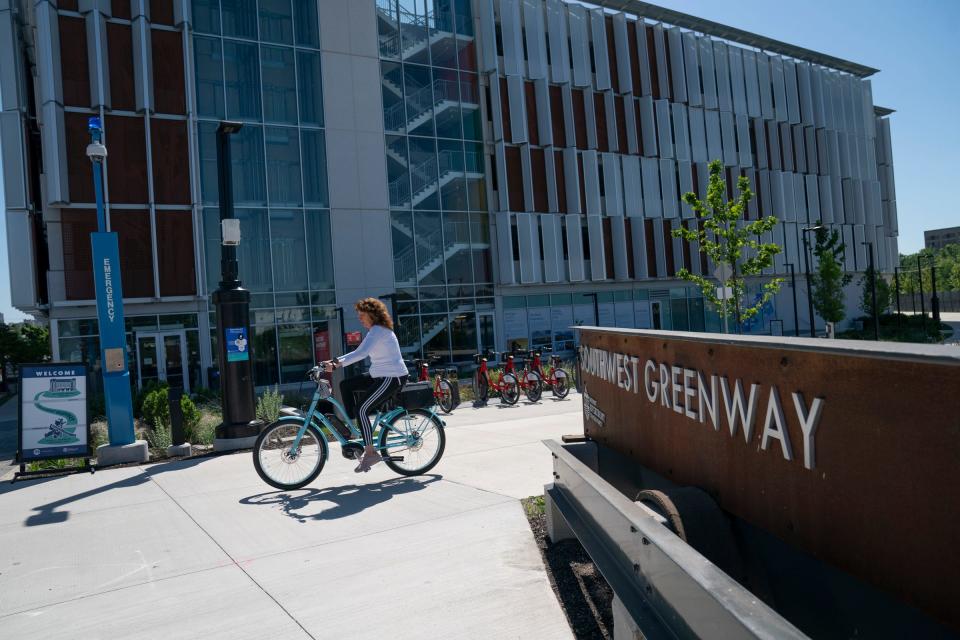Ford changed Michigan Central Station design plans after southwest Detroiters spoke up
When Bill Ford announced the purchase of Michigan Central Station in 2018, he publicly promised residents of Corktown that Ford Motor Co. wouldn't be launching a corporate takeover of Detroit's oldest neighborhood.
A dozen meetings were scheduled to get community feedback and hear concerns that could help shape the direction of the project. As a result, Bill Ford told the Free Press, the design team leading the multimillion-dollar restoration effort on the train station abandoned in 1988 actually made significant changes to building plans and language used to discuss the site.
First, the idea of putting a giant parking garage in the back of the train station was scrapped. Instead, a structure that doesn't look like a parking garage, called the Bagley Mobility Hub, was built just down the street from Michigan Central Station. This was done so the thousands of people in southwest Detroit could keep their original view of the station from the south.

Second, rather than calling the Michigan Avenue side of the station the "front" and the south side of the station the "back," Michigan Central vernacular now refers to the front and "south of station." For many residents of southwest Detroit, the so-called "back" has been viewed as the front for generations. (This is the view from the popular Honey Bee Market off Bagley in Mexicantown, for example.)
As a result, the final design of the remodeled station will have two main entrances, on both sides, rather than just one.
'You’re our gateway too, but you turned your back to us'
So many people approach Michigan Central Station from the Bagley side that it only makes sense, said Mary Culler, who is overseeing the strategic direction of the train station as president of Ford Philanthropy, formerly known as the Ford Fund.
Perhaps most importantly to residents, Ford no longer refers to the Michigan Central Station campus exclusively as Corktown but instead includes southwest Detroit.

"I think we took much more care this time with the community around us to listen to them and ask them, 'What would you like us to do and what would you like us not to do?' " Bill Ford told the Detroit Free Press. "We want to enhance the life of this area but we don’t want to diminish it in any way. So tell us what that looks like."
People in southwest Detroit called out Ford almost immediately, he said.
"When we announced this, everything was Corktown, Corktown, Corktown," Ford said. "The southwest leaders said to us, 'Well wait a minute. In many ways, you’re our gateway too, but you turned your back to us.' So, they didn’t mean literally. Well, literally, yes, the station physically turned its back there. So they got to us in time though, where we could say, 'Wait, we can help change that.' "

So designers went back to the drawing board, he said.
"We really wanted to bring the two communities together in a way that we never thought of when we first bought the station," Ford said. "It faced Michigan Avenue. It was always referred to as part of Corktown. We didn’t think of it at all as part of southwest Detroit. That changed as we got into this. That was an early listening that we took advantage of."
Corktown history plays a role
Corktown, which is named for County Cork, Ireland, is where Irish immigrants lived after arriving in Detroit. The father of Henry Ford, founder of the auto company, left Ireland during the potato famine.
"We still have an operation there," Bill Ford said in 2018. "Of course, there it’s called Henry Ford & Son. It’s not called Ford Ireland. The reason for that is, when Henry first wanted to open something in Ireland, his shareholders said no, that’s not a priority for us. So, he opened with his own money, he opened our Cork operation. But he couldn’t call it Ford Motor Company, so he called it Henry Ford & Son. It eventually got bought out quite quickly by Ford Motor Company. But the name is still Henry Ford & Son there."
Restoration of Michigan Central Station has made international headlines. Many people of County Cork see the project as honoring their relatives who came to Detroit on the potato famine ships, Ford said.

And now the project is about serving as a connection between the neighborhoods initially bifurcated by the station, railroad tracks and the Vernor Viaduct. What has been pedestrian unfriendly is being transformed over the next year or two, Culler said.
"When I did the community benefit meetings, I learned so much from the community," she said. "From the very first, the southwest community said, 'You keep talking about the front and back of the building, and you’re going to put a parking deck on the back of the train station. ... That’s not the back. that’s our front what we look at. That completely changed our entire viewpoint of the building."
People spoke out, Ford responded
Detroit City Council Member Gabriela Santiago-Romero, who represents southwest Detroit, told the Free Press that she attended the community meetings and listened to concerns as they unfolded.
"The community was very vocal about making sure they were included and they were not seen as a community on the back end," Santiago-Romero said. "Really, Michigan Central Station, where it's located, is the entryway to southwest Detroit. I think the community wanted to make sure that we created something that connected us instead of continuing to further divide us."
She continued, "The redesign or design, I do appreciate the intentionality. I’m excited about what they’re going to build. They’re being very intentional. ... The community said, 'Think bigger.' "
Unfinished business: 12 acres of green space
While many elements of the restoration project were delayed by the COVID-19 pandemic, 12 acres of proposed green space on the south side of Michigan Central Station campus suffered the greatest delay, Culler said. "We are retaining some track for potential future use, but all of that will be green space open to the public."
The greenway will connect walking and bike paths all the way to the Detroit River.

Early research for the project indicated young people who lived in the city and worked at or around the Michigan Central Station campus would want to walk to work or bicycle instead of driving. So when the long-abandoned Detroit schools Book Depository next door was restored and designed as Newlab at Michigan Central with workspaces for startups, it included bike storage and showers. Hundreds of people already work at Newlab, which opened last year. Worksite shower facilities are a common amenity in Silicon Valley and San Francisco, where people bike miles to work to avoid traffic and high parking costs.
"Already, you can walk down to the riverfront in less than 10 minutes," Culler said. "You'll be able to get on at Belle Isle, ride your bike all the way up the greenway, come up on our public space, park your bike, stop to get a coffee and get back on the Joe Louis Greenway."

During one night of the NFL draft in April, Culler said she parked at the back of the Bagley Mobility Hub and walked 1? miles to Campus Martius and then back again sometime around 10:30 p.m. Michigan Central Station was lit up in blue "like a jewel box," Culler said.
"I remember thinking, 'What if I was making this walk six years ago?' It would've been 30 acres of darkness."
More: Michigan Central Station: How secret basement, flooding nightmare led to renovation delays
Editor's Note: The reporter's husband worked on the train station as an electrician employed by Conti. And her great-great grandfather founded T.J. Wall & Sons paint company in Corktown in the 1800s.
Contact Phoebe Wall Howard: 313-618-1034 or [email protected]. Follow her on X, formerly known as Twitter @phoebesaid. Read more on Ford and sign up for our autos newsletter.
This article originally appeared on Detroit Free Press: How Ford, Michigan Central Station listened to southwest Detroiters